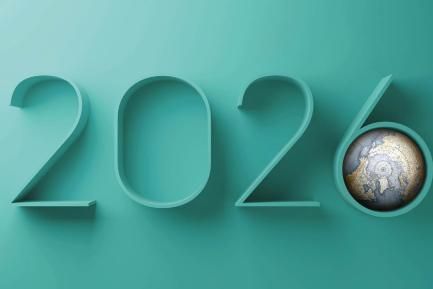
United States
The US economy has proven to be remarkably resilient in 2025 despite a complex landscape marked by trade tensions and high political and economic uncertainty. In the first half of 2025, GDP grew at an annualised rate of close to 1.6%, driven mainly by technology investment (AI), which contributed 1.4 pp, and by consumption which, despite slowing, is continuing to make a contribution, even amid weakening confidence and rising prices due to tariffs.
| Forecasts | ||||||||
|---|---|---|---|---|---|---|---|---|
| 2020 | 2021 | 2022 | 2023 | 2024 | 2025 | 2026 | 2027 | |
| GDP growth (%) | –2.1 | 6.2 | 2.5 | 2.9 | 2.8 | 1.8 | 1.8 | 2.0 |
| CPI inflation (%)* | 1.3 | 4.7 | 8.0 | 4.1 | 3.0 | 2.8 | 2.8 | 2.2 |
| Fiscal balance (% of GDP) | -14.1 | –11.4 | -3.7 | -7.8 | –8.0 | -7.4 | -7.9 | –8.0 |
| Public debt (% of GDP) | 132.5 | 125.0 | 119.1 | 119.8 | 122.3 | 125.1 | 128.7 | 132.7 |
| Reference rate (%)* | 0.4 | 0.1 | 1.7 | 5.0 | 5.1 | 4.2 | 3.3 | 3.1 |
| Exchange rate (USD/EUR)* | 1.1 | 1.2 | 1.1 | 1.1 | 1.1 | 1.1 | 1.2 | 1.2 |
| Current balance (% of GDP) | -2.8 | -3.6 | –3.8 | -3.3 | -4.0 | -4.0 | -3.6 | -3.6 |
| External debt (% of GDP) | 96.7 | 94.2 | 91.7 | 91.4 | 92.6 | 98.4 | 100.1 | 101.3 |
Notes:* Annual average. The growth, inflation, interest rate and exchange rate forecasts are our own. The other forecasts are from the IMF Source:CaixaBank Research, based on data from the IMF (via Workspace). Forecast | ||||||||
Outlook
The US economy has proven to be remarkably resilient in 2025 despite a complex landscape marked by trade tensions and high political and economic uncertainty. In the first half of 2025, GDP grew at an annualised rate of close to 1.6%, driven mainly by technology investment (AI), which contributed 1.4 pp, and by consumption which, despite slowing, is continuing to make a contribution, even amid weakening confidence and rising prices due to tariffs. The investment cycle will remain the main driver of growth and household consumption will recover as financial conditions continue to ease and uncertainty subsides. We expect the US economy to grow at around its potential rate (2%) over the next two years.
Inflation remains above its 2% target. Although the prices of services (the most resistant to decline) have started to fall, tariffs are introducing new upward pressures and the prices of goods have started to pick up. However, the pass-through of tariffs to final consumer prices has been slower and less pronounced than expected, as companies built up their stocks earlier in the year and have absorbed a considerable share of the higher costs into their margins. We expect tariffs to cause a one-off, temporary price increase, whose impact will fade by the end of 2026, with no second-round effects.
The job market has been hit by a supply shock due to the White House's immigration policies, which have reduced the foreign labour force. At the same time, employment demand has been dampened by high uncertainty. As a result, job creation has slowed, but the combination of cooling supply and demand conditions has kept the unemployment rate at historically low levels of around 4.3%. Risks remain to the downside, amid cuts in public sector jobs, uncertainty and AI adaptation, as well as continued restrictive migration policies.
Economic policies
We expect the Federal Reserve to move interest rates towards neutral levels (3.00%-3.25%) although the path is uncertain, as there is tension between the Central Bank's two objectives (maximum employment and price stability), which require different approaches. There is no clear consensus within the Fed's Board and decisions will be made on a data-dependent, meeting-by-meeting basis.
Fiscal policy remains expansionary as the outlook worsens. The One Big Beautiful Bill Act approved in 2025 prolongs and extends the tax cuts implemented in 2017. The new tax credits may boost consumption and investment in the short term, but they are hastening the deterioration of public accounts, which will not be offset by increased revenue from tariffs. The IMF forecasts that gross public debt could exceed 140% of GDP by the end of the decade. The US has now lost its top credit rating with all three major rating agencies, which, alongside high debt issuance, is keeping long-term interest rates at elevated levels.
The dollar has weakened in 2025, although it has levelled out in the latter part of the year after rallying in late 2024. This is due to lower interest rates, a weaker fiscal outlook and political turmoil. Downside risks remain due to a further cooling of activity, uncertainty and the weakening of institutions. However, its role as the dominant currency and safe haven asset limits these pressures, while a less accommodative Fed than expected would create additional upward pressures.
Risks
- Commercial risk. Tariff tensions continue with some trading partners and uncertainty remains about the temporary nature and legality of the tariffs, as well as their eventual impact on activity and prices. Higher inflation would make the Fed's work more difficult and erode households’ disposable income, acting as an additional drag on activity.
- Technology risk. There are growing doubts about the sustainability of the investment boom in technology companies, and AI's impact on productivity and its ability to yield sustainable profits is still unknown. If expectations are not met, a correction in stock market valuations could occur in the medium term. This will have financial implications whose magnitude will depend on the rise in credit and debt that accompanies the investment boom in the coming years.
- Fiscal risk. Persistent deficits and steadily rising public debt raise serious doubts about the country's fiscal sustainability, which could raise financing costs, weaken the dollar and lead to further sovereign credit rating downgrades.
- Institutional credibility risk. 2025 has seen unprecedented friction between the White House and the Fed, with attempts at political interference in steering monetary policy. Furthermore, difficulties in reaching agreements in Congress are affecting governance, and the withdrawal of the US from various multilateral bodies is eroding its role as a global leader and reliable partner.
Sovereign credit rating
| Rating agency | Rating* | Last changed | Outlook | Last changed |
|---|---|---|---|---|
 | 05/08/11 | Stable | 10/06/13 | |
 | 16/05/25 | Stable | 16/05/25 | |
 | 01/08/23 | Stable | 01/08/23 | |
| investment gradeSpeculative grade | ||||


